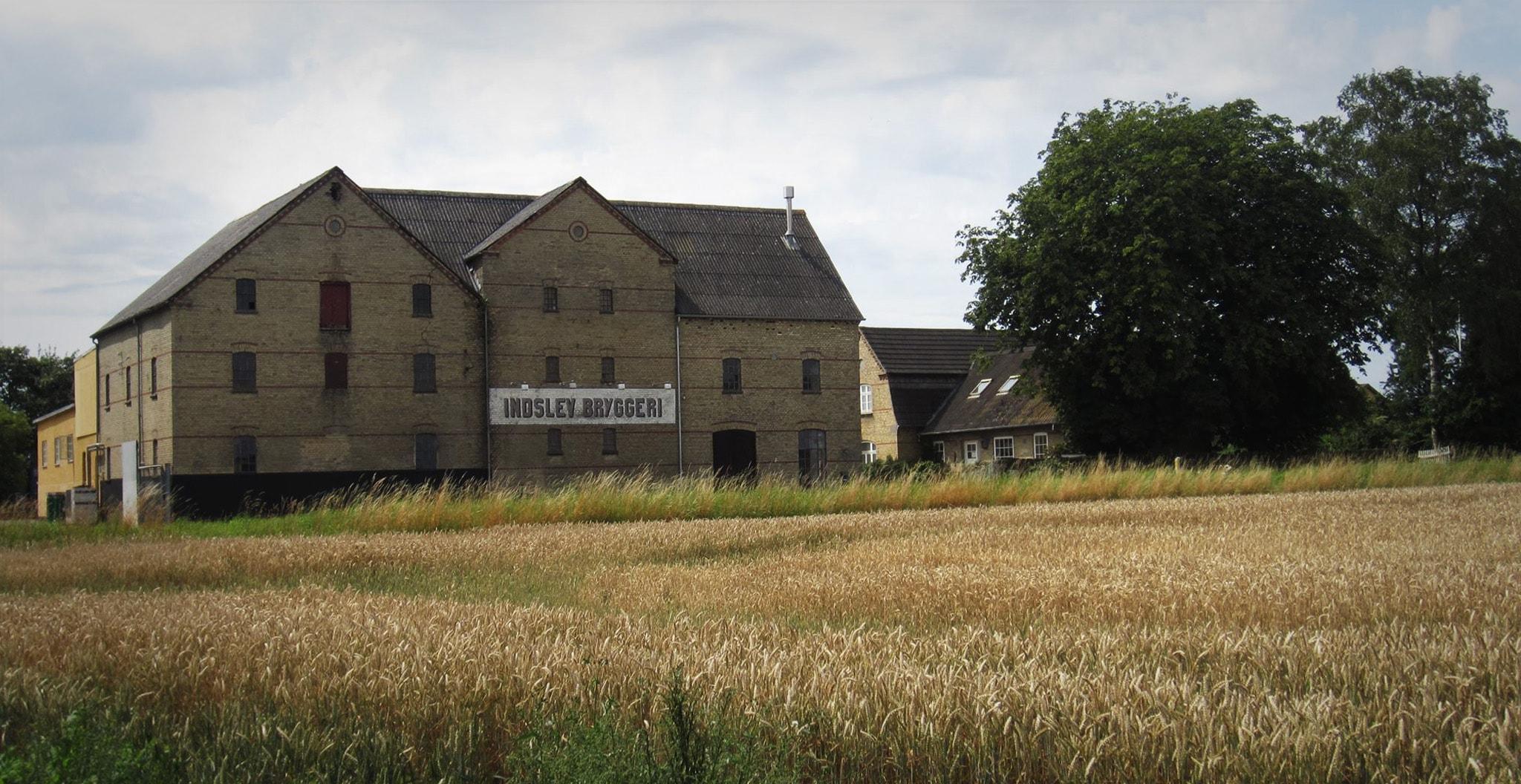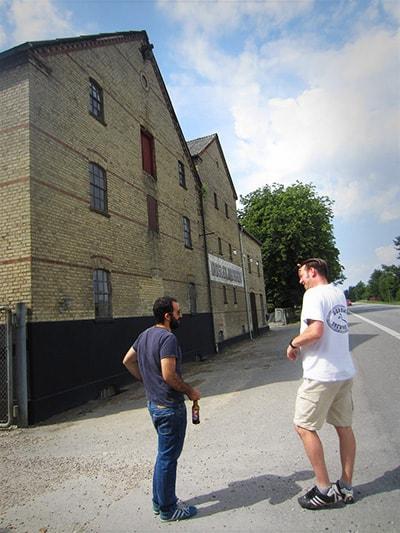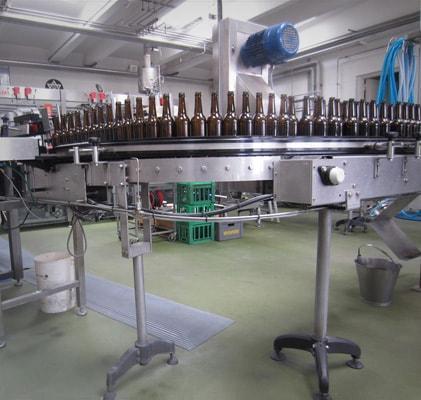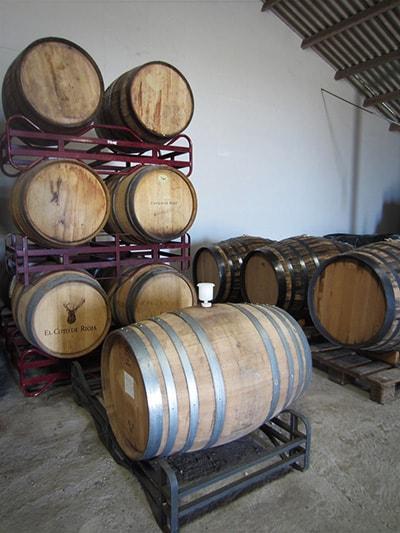Indslev Bryggeri, Ugly Duck
Ducks With Roots
Escrito por Jesús Olano—Fotos por Adriana Barbeito; Indslev (Denmark), 25/09/2016 beerbayOU

“They call us the lazy island, but we are also the more laid back” says Mike with a bit of irony while making a tour around the brewery. Indslev brewery was founded in 1897, and it remained as a family business until the 80s, when it had to close. In 2006 it opened again when Anders Busse Rasmussen retook the family business, trying to combine it with the emerging brewing scene that was starting back then in Denmark. Their first focus was to reintroduce the traditional name, Indslev Brewery, but focusing just in wheat beers, a concept that they pioneered in Denmark. But that was too narrow for their willingness to experiment, so in 2012 they created a new brand “where to experiment with more extreme beers”.
As we tour through the brewery, Mike explain us how the different processes work and how they understand the business—and the art—of brewing “we don’t want any of our beers to leave the brewery unless we are happy with them ourselves, because if we are not happy, lots of other people won’t be happy either.” Mike Anderson started working as Marketing/PR/Event Manager in Ugly Duck after spending some years in one of Odense’s best beer bars, Carlsens Kvarter, and now he is one of the men behind Ugly Duck Brewing. After touring we were also joined by Stefan Peter Stadler, the brewmaster behind some of Ugly Duck's recipes.

Why “Ugly Duck”?
“We don’t want any of our beers to leave the brewery unless we are happy with them ourselves. Because if we are not happy, lots of other people won’t be happy either.”
Mike: Indslev is local and had the child that was Ugly Duck. And Hans Christian Andersen house is 25 km. from here, and the island is sort of HC Andersen, but Ugly Duck is just that... sounds better than Ugly Duckling. And so we use the Ugly Duck in our marketing “let’s go hunting for ugly ducks”. Hunting season is all year, so we can play off. And actually, at the Indslev Brewery we only sponsor one person, who is Nicky Pedersen, speedway world champion, and we have his left knee and the back of the saddle. And then we can use “svanen giver vingerne”—the swan gives the wings.
You have used some funny names for your beers, like Obama, Putin, Follow the White Rabbit or Miami Vice. What is the inspiration for naming a beer?
Mike: The first year and a half the beers were called what they are. There is the Rye Porter, it is a Porter on Rye. There is a Simcoe and Chinook IPA, an Amarillo and Citra IPA, there is the Nelson Pale Ale, there is the Sorachi Aced, they all just refer to the type of beer that was in there. But after we’ve done that, and people sort of knew what it was, then it became a bit more free. So the Miami Vice is a american retro Pale Ale, so it is not the new tropical hops, it is sort of the old school american hops. And the 80’s version, Martin who was with us at the time, and who was the brand manager for Ugly Duck by that time came up with the idea of if we make it Miami Vice, that signals America, it also signals the 80’s, and it was nice for the text in the back label, we even had the Ferrari. So the youngsters today they even think it is Grand Theft Auto Miami Vice, and the ones that are a little bit older, they remember the TV show. And also the graphics, they are really great. So we’re now more or less in a situation that when it is not busy in the brewery—in Friday it is always the most relaxed day—, because we just prepare for Monday. Then there will be a lot of us—Stefan and Anders—that we will just meet up somewhere and at some point somebody says “how about we make a double IPA?”. ”That’s a good idea, what can it be called?” And then we just start the brainstorm for 10 minutes.
So sometimes you first have the name and then make the beer...
Mike: For example, Golden Eye came up last year. We wanted to do a Belgium inspired Golden Ale. And at the same time, the newest James Bond movie came out. So we have already used “golden shower”, so we couldn’t use that. That [beer] is exclusively for Sweden. But Golden Shower is a good example. We don’t want people to find us arrogants, but we want people to think that we have humour and that we can laugh at ourselves. But Golden Eye was simply because the newest James Bond movie came and somebody said “hey, wasn’t there a James Bond movie called Golden Eye?” And then we used for the graphics on the labels, are simply the backgrounds from the intros to the 70’s James Bond movies, with this sort of “psychedelic bubbles”. The Double Retro is because we wanted to make an American beer from the 70’s with the American hops, and it is not a new beer, in the sense that the new beers are the hybrid beers, or the electrical beers that are sort of up today, that are sort of modern today. So that’s why there is a Corvette and a Mustang in the beer, because it has to ressemble the beer. We have a Quadruple coming out. A Quadruple is a Belgium Catholic beer, which now we are going to call it Hail Mary, which is like “Ave María”, but it is also from the American Football, when the quarterback closes his eyes, and just throws the ball and hopes one of his own teammates gets it. So the label is going to be probably the Virgin Mary with a football in her arm and a helmet on. The White Rabbit was going to be a White IPA on brettanomyces, so what should we call it. And the white rabbit just gave us so many good references. There is Alice in Wonderland, and there is a song by Jefferson Airplane, The Matrix—follow the white rabbit—, and all that. So that is how it comes up now. And I actually have four names for beers that have not actually been brewed. Just because they are good names. But Putin and the Obama, that is a really good story. The Putin is a pitch black 8,9% strong very masculine beer. It is quite hoppy, it has a smoked malt. And that’s what Putin wants to signal himself, he wants to be a really strong masculine man. And also, if you read the back label, it seems like is really positive to Putin, which it could be for anyone who feels that way. You could also read it with irony, like “he has a black mind and he is the Dark Lord of the Sith”. We don’t want to piss anyone, but it is just that it fits that he is a pale white guy. And it is a black masculine beer. So when the idea came to make a new more tropical American Pale Ale, we wanted to be Obama, because he is a dark guy, but he has a light mind. And the beer also is really pale and really fresh. And they also play off well with each other. If you have the Putin, you must have the Obama, and the other way around. We had a 300 l. version of the Putin that went into a Rioja barrel and we put blackberries in there, and we wanted it to be named Putin Berries, but that was a bit too provocative, so the choice we make is to name it Putin’s, and then you can make up the rest.
As you are located in an old brewery, how do you think that influences Ugly Duck?
“In the Ugly Duck it is more the craftmanship, it is the people behind who are so greatly skilled.”
Mike: In the Ugly Duck it is more the craftmanship, it is the people behind who are so greatly skilled. The Indslev line is also creative in the sense that it is very narrow when you only want to make wheat beers. But among the wheat beers, there is the wheat bock from an old wheat type called spelt. There is also an English Pale Ale with Amarillo hops, which at the time it was unheard of, that you made a wheat beer that was also a Pale Ale. And the Sort Hvede [Black Wheat] is a Sweet Stout, but it is a Sweet Stout with smoked malt. And it is a Sweet Stout that is also on wheat. And that was sort of revolutionary. So even the sort of small narrow wheat beer, we made sort of novelties in there, and that’s what is continous with Ugly Duck. Actually there are no boundaries—if you have a great idea, just go for it. The Indslev is the same but is a little bit more limited—as it has to be a wheat beer. So there is no direct comparison in the history of the brewery on making Ugly Duck, other than the name. But it is all about craftmanship, which is also the case for Inslev and Ugly Duck.

About brettanomyces. Why do you use them? How does it make the process different?
Mike: Well, in the beer world, it turns out that there are things that are modern, and beers that are not modern. It goes up and down. Brands change and times change. And right now and for a while it has been the sour ales. Brettanomyces is really fun for the brewers to work with, as you don’t know how it is going to turn out. Also that makes it really dangerous to work with. And it is really hard to make the next brew after you use brettanomyces and make it so it doesn’t taste like brettanomyces. So it was a good challenge. And it was also our contribution to the trend of sour ales. We wanted to do a Farmhouse Ale for years. We had the labels made two years ago. And then the beer itself didn’t come out until February this year. But it was brewed in August last year. And we had to try to kickstart the process to get it fermenting again, because the brettanomyces, the first ones they just died out and it didn’t get enough of the taste, especially the bouquet. So that’s what we've been working on for more than six months before we were satisfied. Because we don’t want any of our beers to leave the brewery unless we are happy with them ourselves. Because if we are not happy, lots of other people won’t be happy either. But it turned out really good, and the process was really fun for the brewers, and now he have lots of brettanomyces, so we might as well go on with it. So we made the White Rabbit, a White IPA on brettanomyces, and it also turned out great. It is one of my favourite beers that we have. Because it has that softness from the wheat, it is pretty hoppy, it is IPA hoppy, we used Azacca hops for the first time in that beer. So it also has the bitterness and it has that retarded acidity sourness, especially in the bouquet. It is so fun to work with. So we are going to keep doing that. We have a Quadruple on brettanomyces coming out, and also in collaboration brewings is fun to work with. So for us it is not just a trend. We want to do something we are good at and get better at doing it. And also Stefan will tell you how the Farmhouse was such a long process.
Stefan: We made a lot of tries, and the first set that was brewed was such a mess... Because you can’t find books about this, so you have to start from scratch, and then try, and taste.
Also when brewing your collaboration with De Molen Nothing but Trouble, as the name says, it gave you a lot of trouble, didn't it?
Stefan: The first brew started Thursday morning, it was transferred to the water at 2pm, and after about 5 hours we had 5 hectoliters. The next morning we had about 5.8 hectoliters, so we were really in trouble. We had done too much, and we knew this can cause a lot of trouble. So the next day we took it out and for the next brew we decreased the number of beers. So this one was quite OK. So we did a second brew that day. This was a very long day. We had a lot of our friends there who were having a lot of beers and food, and dinner, while we were working our asses off the process.
Mike: The original name was also supposed to be in Dutch, Eenden en Mollen—ducks and mills. But we altered it to Nothing but Trouble, because that’s what it was. But it is a really great beer.
Stefan: It was not only trouble, it was a lot of fun. And the result was outstanding.
Mike: There were a couple of bloggers invited out here, they were at the process. Martin Petersen from stovt.dk was here. And that is also a lot of fun, because they get sort of a different approach to what actually goes on in the brewery.
About barrel-aged beers, do you have any upcoming project?
Mike: Right now in barrels we have an Imperial Red Ale ready. We have a Quadruple that we were talking about before. We have a wheat wine and a barley wine. And Middlefart Double, that’s actually not our beer, but it is in brandy 300 l., portuguese brandy, Macieira. And that is sort of the concept, we can take existing beers and put 300 l. in a barrel and just to see what happens. Because the first time you use the barrels it will give you a different taste than the second, because you have taken out some of the taste. It takes longer. But on the Nothing but Trouble series there were six different kinds of barrels and a base beer. We are brewing it again in the future and we are doing it in a Sherry version, Pedro Ximénez, instead of all six.

About the videos, how do you use them to communicate your brand?
Mike: We sort of limit ourselves on purpose. We don’t have very much money to spend on marketing—and on commercials, ads and stuff. But we have the idea that if we only put beers on the market that we think are good, people will taste them and tell the difference. So it is sort of the long and hard way to do it. But with social media now there is a great market. And our websites, both Indslev and Ugly Duck, are kind of stationary, there is nothing going on. We will send some newsletters in the future. But the thing is that Facebook, Instagram, YouTube, they are used more and more. And we are lucky enough that we have some great ideas. And we have an art director who is a vulcano in eruption of creativity. So if he gets an idea—he get lots of ideas—he will make some suggestions and we can leave them or we can use them or whatever. And we use it more and more. And also the newest example is the first of the car collections videos, where the art director—he loves cars and I do too—thought “could we make something that combines our beer with something that not many others have done?” Because we had loads and loads of pictures of beer and food—and our beers go great with food—both brands, but then we thought “what if there is just guys and girls hanging out and doing something else, and the beer is there, but the focus is not on the beer?”. We wanted to be either subtle or to have the combination. So right now we are just working on the combination of beer and food for Indslev mainly, and then we are going to make a series of “car collection” or “fixing the car collection”, and we will use more powerful cars blowing the foam from our glasses. We will use bigger and bigger engines and bigger and bigger sounds. It is fun for us, it is fun for the people in the brewery and it’s not really been done before. And the first of these ads is by far the most seen of our ads ever. And it was not that expensive to do it. We just had our art director with his own car and filmed it with his own camera and we started the car ourselves. But now there is so much envolvement in this area that we cannot do it all ourselves, so we have a company that helps us out from time to time. And I think that’s the way for us to go.
Is it also your art director [Alan] who makes the labels?
Mike: Yes, we come up with the ideas, and then he will translate it into a picture of some kind that we can use. And for every beer he will have like four or five versions of it, and he is really fast. I have heard from another breweries where they use an art director, that it can take up to 2 months on making a new label. But Alan, he takes perhaps two days, he is really fast. So when we made a version of the old Miami Vice, which is also a collaboration with three Austrian brewers. So it is Miami Weiss. So we could either put a Puck or some kind of vehicle from Austria, but there aren't that many. So we put a goat standing, just to play off the ideas. That’s what happens with mainly all of the new Ugly Duck beers. They are really different. But the Indslev are all the same, as you have to recognise the label. And then they are different colours.
When you reopen the brewery, you tried to get locals as shareholders. How do you involve them with the brewery?
Mike: Anders, the director, is from here originally. And it’s his family who started it up around 1890’s. And from around the late 1980s until 2006 it was not run by the family. And he wanted to be an entrepreneur. But it didn’t have to be beer, it just turned out that way. So all the locals, at least the older ones, they already knew the place. Some of them bought beer here when they were kids back in the forties. And also we used ,and still do, some local helpers who simply come out and help us when there is something special going on. And we have a project with hops that were grown just to the brewery. They contacted us and we gather twenty people and brewed a beer with it. We use the swan and the duck as local references, so we are really well known in the area. And we also have our little shop right here that is really well visited. And people can get all our products. And they are not especially cheaper or more expensive than anywhere else, but you can just get everything. We have a lot of tours, people came in groups and see the brewery. So we are a very integrated part of the local community, which is great because, especially with the history of the brewery, that’s exactly what we want.

About your last brews. Could you tell us a little bit more about the White Rabbit and the Farmhouse Ale?
Mike: With the brettanomyces of the Farmhouse Ale, the White Rabbit came up as, “should we try to make something else than we did before?”. In the early days of Ugly Duck there were only Pale Ales and IPA’s and then pitch black strong beers. So they were the sort of the two beers they were taking out. But after a couple of years we thought we already have done that, so we started opening up to more types of beer, and that’s what’s happening right now. We were going to take out two of our IPA’s and one of our Pale Ales, so we have space for the new ones, but we didn’t want to have new ones that ressembled the old ones, so the white IPA is the first IPA we made with Azacca hops, it has different ABV than the one that went out. The one that went out is 5.9%, this one is 7.5%, the taste is so different from the use of the brettanomyces especially, so it is a brand new beer with a brand new type. We are doing the same thing with the new Quadruple, the Imperial Red Ale and the Barley Wine. So it is all new types coming out now. And even the types that we had before, like the IPA, it is a new take, so it doesn’t remind you of the old beers. On the other hand the Obama and the new Miami Weiss are pretty close to the original Miami Vice, but that’s what happens when you only have 4.6-4.7% to work with, they will ressemble each other more than a Barley Wine will resemble a Rye Porter, for instance. So the next beers coming out will be darker, stronger and more powerful beers, and not like hoppy beers. But we don’t have a production plan one year in advance. We have a production plan that sometimes we meet up and one of the brewers has a good idea and then in two months the beer is brewed and out on the market. We want to have it fresh all the time, which works great by the way.
Corrected and edited by Dave Allington